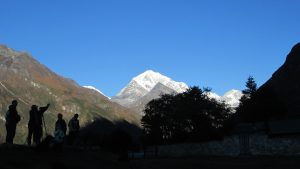Trekking to Everest Base Camp in July presents unique challenges and rewards amidst the stunning Himalayan landscapes:
Weather and Conditions: July marks the peak of the monsoon season in Nepal, characterized by frequent rain showers and cloudy skies. The Everest region experiences heavy rainfall, which can make trails muddy, slippery, and challenging to navigate. Trekkers should be prepared for variable weather conditions, including fog and reduced visibility.
Scenic Beauty: Despite the rain, July brings lush greenery and blooming wildflowers along the trekking route. Waterfalls cascade down the mountainsides, creating picturesque scenes amidst the misty atmosphere. Trekkers can witness the region’s natural beauty in its most verdant state, with fewer crowds on the trails.
Less Crowded Trails: July is considered an off-peak season for trekking to Everest Base Camp, resulting in quieter trails and a more tranquil trekking experience compared to peak seasons. Trekkers can enjoy a sense of solitude amidst the serene and untouched landscapes of the Himalayas.
Challenges and Considerations:
· Rainfall: Be prepared for heavy rain and wet conditions throughout the trek. Waterproof gear, including rain jackets, pants, and covers for backpacks, is essential to stay dry and comfortable.
· Leaches: Due to the wet conditions, leeches might be present on the trails, especially in forested areas. Wearing leech socks and applying insect repellent can help prevent encounters with these creatures.
· Flight Delays: Flights from Kathmandu to Lukla are subject to weather conditions, and delays or cancellations are common during the monsoon season. Plan for potential disruptions and consider including buffer days in your itinerary.
Cultural Experience: Despite the rain, July offers opportunities to engage with local Sherpa communities and experience their hospitality. Learn about their traditions, visit monasteries along the way, and witness local festivals if they coincide with your trekking dates.
Trekking to Everest Base Camp Hiking in July requires careful preparation, flexibility, and a spirit of adventure to embrace the challenges and rewards of trekking during the monsoon season. With the right gear, mindset, and respect for the environment, trekkers can enjoy a unique and memorable journey amidst the awe-inspiring landscapes of the Himalayas.
Weather at Everest Base Camp in July
July marks the peak of the monsoon season in Nepal, bringing distinct weather patterns to the Everest Base Camp trekking region:
Rainfall: July is characterized by heavy rainfall throughout the Everest region, including frequent afternoon showers and occasional thunderstorms. Rainfall can vary from light drizzles to intense downpours, significantly impacting trail conditions.
Temperature: Despite the rain, temperatures at lower altitudes remain relatively mild, ranging from 15°C to 20°C during the day. However, at higher altitudes, especially at night, temperatures can drop significantly, requiring adequate cold-weather gear.
Cloud Cover: Cloudy skies are common in July, often obscuring panoramic views of the Himalayan peaks. Trekkers may experience limited visibility, especially during early morning mountain viewpoints.
Humidity: High humidity levels contribute to a damp environment, making trekking conditions challenging. Humidity can affect comfort levels and the drying of clothes and gear between rainy spells.
Advantages of Trekking in July
Despite the challenging weather conditions, trekking to Everest Base Camp in July offers unique advantages:
Less Crowded Trails: July is considered an off-peak season for trekking in the Everest region, resulting in quieter trails and a more peaceful trekking experience. Trekkers can enjoy solitude amidst the lush green landscapes and cascading waterfalls.
Green Landscapes: The monsoon rains rejuvenate the Everest region, transforming the surroundings into vibrant green valleys and blooming wildflowers. Trekkers can witness the region’s natural beauty in its most verdant state.
Cultural Immersion: July provides opportunities to interact with local Sherpa communities and experience their traditional lifestyle. Learn about Sherpa culture, visit monasteries, and witness local festivals, offering insights into Nepal’s rich cultural heritage.
Difficulties of Everest Base Camp Trek in July
Trekking to Everest Base Camp in July presents several challenges that trekkers should be prepared for:
Weather Variability: Unpredictable weather patterns can lead to sudden rain showers, fog, and reduced visibility, impacting trekking conditions and mountain views.
Trail Conditions: Heavy rainfall makes trails muddy, slippery, and potentially hazardous. Trekkers must navigate through challenging terrain, requiring caution and proper footwear.
Leeches and Insects: Wet conditions in July may attract leeches and insects along the trekking route, particularly in forested areas. Wearing leech socks and applying insect repellent is recommended to minimize encounters.
Flight Delays: Flights from Kathmandu to Lukla are prone to delays or cancellations due to adverse weather conditions, affecting the start of the trek. Plan for potential disruptions and consider flexible travel arrangements.
Trekking to Everest Base Camp in July demands preparation, resilience, and adaptability to embrace the challenges and rewards of trekking during the monsoon season. With the right gear, mindset, and respect for nature, trekkers can embark on a memorable adventure amidst Nepal’s majestic Himalayan landscapes.
Tips for Trekking in July
Trekking to EBC Trek in July requires careful planning and preparation to navigate through the challenges posed by the monsoon season:
Weather Awareness: Stay updated on weather forecasts and be prepared for sudden changes in weather conditions. Carry waterproof gear, including rain jackets, pants, and covers for backpacks, to stay dry during frequent rain showers.
Footwear and Traction: Choose sturdy, waterproof trekking boots with good ankle support and non-slip soles to navigate muddy and slippery trails. Trekking poles can provide added stability on uneven terrain.
Pack Light: Pack essential items only to minimize weight and maximize mobility. Prioritize quick-dry clothing, moisture-wicking base layers, and warm layers for colder temperatures at higher altitudes.
Hydration and Nutrition: Drink plenty of water to stay hydrated, even in cooler temperatures. Carry energy snacks such as nuts, dried fruits, and energy bars to maintain energy levels during long treks.
Health and Safety: Be mindful of altitude sickness symptoms and acclimatize properly. Carry a basic first-aid kit with medications for headaches, nausea, and altitude sickness (e.g., acetazolamide). Protect against leeches and insects with appropriate repellents.
Packing List for Everest Base Camp Trek in July
Packing for the Everest Base Camp trek in July should focus on essentials to stay comfortable and safe amidst the monsoon conditions:
Clothing: Lightweight and quick-dry clothing, including moisture-wicking base layers, insulated jackets, waterproof and windproof outer layers, hiking pants, and thermal underwear.
Footwear: Sturdy, waterproof trekking boots with good traction, waterproof gaiters, and extra pairs of moisture-wicking socks to keep feet dry and prevent blisters.
Gear: Backpack (30-40 liters), trekking poles, headlamp or flashlight with extra batteries, sunglasses with UV protection, and a compact sleeping bag suitable for sub-zero temperatures.
Personal Hygiene: Toiletries (biodegradable soap, toothpaste, toilet paper), hand sanitizer, wet wipes, and a quick-dry trekking towel.
Health and Safety: Personal medications, first-aid kit (including altitude sickness medication), insect repellent, sunscreen (SPF 30+), and lip balm with UV protection.
Hiring a Guide or Porter in July
Consider hiring a guide or porter for the Everest Base Camp trek in July to enhance safety, convenience, and cultural experience:
Safety: Experienced guides are familiar with trekking routes, weather conditions, and potential hazards. They can provide assistance in navigating challenging terrain and emergency situations.
Logistical Support: Guides arrange accommodation in teahouses, manage permits, and facilitate communication with locals. Porters can carry heavy gear, allowing trekkers to hike with lighter packs.
Cultural Insight: Guides share local knowledge, stories, and traditions of Sherpa communities along the trekking route, enriching the cultural experience.
Peace of Mind: Hiring a guide or porter alleviates logistical concerns, allowing trekkers to focus on enjoying the trek and soaking in the breathtaking Himalayan scenery.
Conclusion
Trekking to Everest Base CampTrekking in July offers a unique adventure amidst lush landscapes and cultural richness, despite the challenges posed by the monsoon season. By packing wisely, staying informed, and considering support from guides or porters, trekkers can embark on a memorable journey while staying safe and comfortable in Nepal’s Himalayas.

